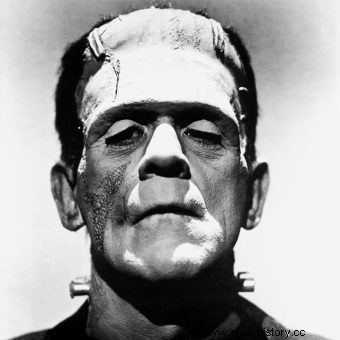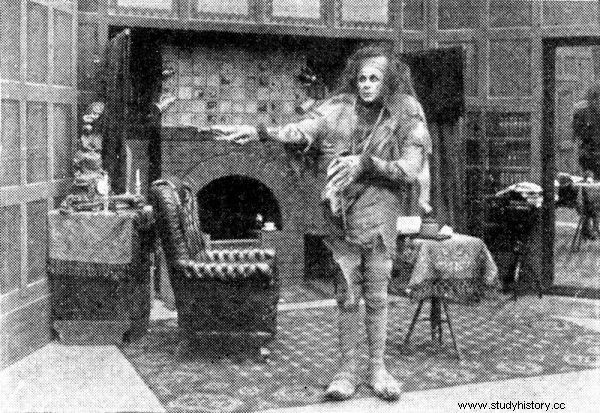Frankenstein's monster, sewn together from fragments of human and animal bodies, was born in the head of an inconspicuous young woman. Where did Mary Shelley get her inspiration from?
The most famous monster in history was born on a stormy night on June 16, 1816, when a group of friends began to invent ghost stories to pass the time. The rider of the game was George Byron, but it was the imagination of a subtle 19-year-old that gave birth to a monster that still haunts this day .

The famous monster was played by, among others, Boris Karloff.
Mary Shelley was the undisputed winner of the competition for the scariest story that Lord Byron had announced that night. However - contrary to what is usually believed - Dr. Frankenstein and his terrifying work did not jump out of the writer's mind like Athena from the head of Zeus. So where did they come from?
The dream monster
As Charlotte Gordon relates in her book "Rebels", Mary herself, a dozen years after the creation of her most famous work, claimed that the idea for the plot of the novel did not come to her immediately. He appeared later - in a dream:
I was involuntarily taken over by my imagination, plunging into my head a series of pictures unequally vivid than dreams normally found in reality. (...) I saw - my eyes were closed, but I saw clearly with my mind's eye - a pale adept of ungodly teachings kneeling over the creature he put together . I also saw that hideous, ghostly figure of a lying man, which then, when the student set in motion some powerful machinery, began to reveal signs of life.

Mary Shelley claimed she just dreamed the idea for the monster.
However, her companions presented a completely different version of events. Percy Shelley, Mary's husband, in the introduction to the first issue of "Frankenstein" wrote that his wife immediately set to work without any difficulties. His version in his diary was also confirmed by John Polidori, who was infatuated with the writer (who, in turn, was completely lacking in inspiration).
So why was Mary not being truthful? Why does she need to diminish her participation in the creation of the Frankenstein monster? Well, 19th century society was not yet ready for this kind of women's creativity.
Information about the gender of the author of the controversial novel caused a shock in some circles. This took a toll on sales figures, and Shelley had to contend with ostracism. Part of this was also due to her scandalous romance with Percy. Emphasizing modesty and convincing readers that the revolutionary storyline was not a talent and imagination, but rather a coincidence - or at least an unconscious twist of fate - was intended only to improve the image of the writer in the eyes of the public.
From macabre legend to literary canon
Consciously or not, Mary Shelley had to get some inspiration from somewhere. From where? As Charlotte Gordon argues in "Rebels", it was enough to reach into her own life:"She created her story based on memories of the meat stalls she knew from Skinner Street (where she lived as a child - ed.), As well as about the legend about Konrad Dippel, which she met at Frankenstein Castle. ”
The latter certainly had a significant impact on the final shape of the novel. It was about a notorious 17th-century alchemist who wanted to find a cure for death - and to do so he conducted gruesome experiments . He stole body fragments from the cemetery, ground the bones to dust, mixed them with blood, and then "watered" other corpses in an attempt to bring them back to life.
If you add to this heated discussions about the theories of the anatomist William Lawrence, electricity and galvanism, as well as stories about ghosts, which colored the long, rainy evenings with a bored group locked in Villa Diodati on Lake Geneva, we get a ready outline of the plot of "Frankenstein".

The first adaptation of Frankenstein, prepared by Edison Studios, was made in 1910.
However, this novel would not have entered the canon of world literature if Mary Shelley had not enriched it with her own experiences of an orphaned by her mother and a child rejected by her father , a young woman condemned for living with her beloved man, and finally - an intelligent observer of the medical revolution, whom she had involuntarily witnessed. As Gordon aptly notes in his book:
Mary started with a story with supernatural elements and ended up with a complex psychological study written from multiple perspectives. Initially, she was interested in whether a human could create life, which was a favorite subject of Shelley and Byron, but eventually she dedicated herself to exploring the secrets of human nature.
The measure of its success in this field is the fact that "Frankenstein, or modern Prometheus" has been adapted to dozens of more or less successful adaptations and is still listed among the most important and groundbreaking books in the world.
Source:
Trivia is the essence of our website. Short materials devoted to interesting anecdotes, surprising details from the past, strange news from the old press. Reading that will take you no more than 3 minutes, based on single sources. This particular material is based on the book:
- Charlotte Gordon, Rebels. The amazing life of Mary Wollstonecraft and her daughter Mary Shelley , 2019 Poznań Publishing House.
